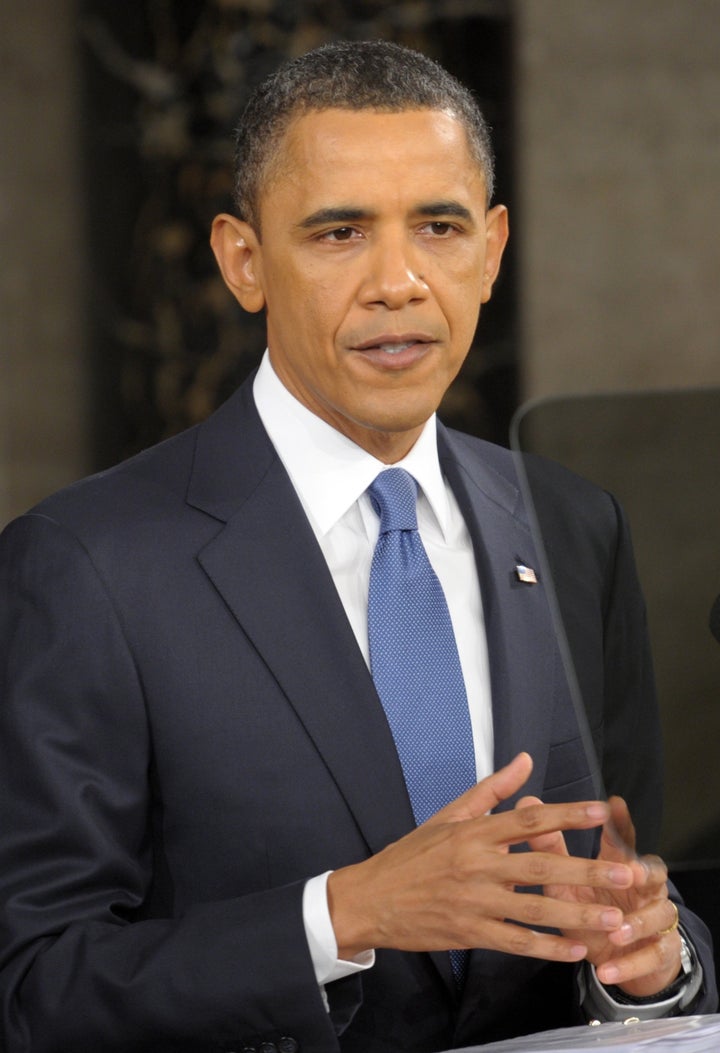
WASHINGTON -- President Obama's second official State of the Union address presented the country with a broad vision of governance in an age of divided political power. But as Obama tried to strike the tone of a president refining his approach following a mid-term election drubbing, on substantive matters his administration doubled down on its agenda.
While Obama skipped over a host of critical policy topics, the proposals he did put forward on Tuesday night either echoed or built off earlier approaches. Even the overarching theme of the address -- that America found itself in a Sputnik moment -- drew from the past, with the president having invoked the space race during a clean energy speech at MIT in October 2009.
On the specifics, the re-affirmation of past positions was more pronounced. The chief domestic policy component of the speech -- a five-year freeze on non-defense discretionary spending to begin, aides say, in 2011 -- advanced the three-year freeze Obama called for during his last State of the Union.
The call for the expiration of the Bush tax cuts for the wealthy brought back memories of the pitched, ultimately unsuccessful, campaign the president waged during last year's lame duck session.
A pledge to fund research and development in the energy sector by cutting off oil subsidies is a proposal Tyson Slocum, director of Public Citizen's energy program, noted Obama has put in each of his previous budgets.
A National Infastructure bank, which would serve as a piggybank of sorts for transportation projects across the country, continues a policy administration officials had championed back in September 2010.
A call for 100,000 science, technology, engineering and math teachers by the end of the decade is an announcement the White House made back in September as well.
A push for one million "advanced technology" vehicles is something that his Energy Department has endorsed as well, albeit with a bit more specificity -- that those one million vehicles be "plug-in hybrids" and that they be "on the road by 2015."
Corporate tax reform, likewise, is an idea that administration officials began advocating a few months ago. Doubling exports was part of the president's State of the Union last year. Reforming laws so that top students weren't expelled because of their immigration status is, in its basic form, an element of the DREAM Act, the law Congress failed to pass last session. Even the president's endorsement of medical malpractice reform -- as odd as it seemed to see uttered from a Democrat's lips -- had been part of a failed compromise on health care reform he embraced when that bill was being crafted.
The list of re-stated policy planks includes the president's pledge to continue policies in Afghanistan and Iraq and his defense of his health care reform legislation, financial regulatory reform, the tuition tax credit and the Race to the Top education program.
If it all seemed like a bit of déjà vu, the audience didn't notice or care. CBS news polled State of the Union watchers and found that 91 percent approved of the proposals the president put forward. On Fox News, a focus group conducted by GOP wordsmith Frank Luntz was noticeably more critical.
A staple of most State of the Union speeches, re-affirming policy ideas is different than recycling them. Obama, for instance, urged Congress to tinker with health care, make the tuition tax credit permanent, and build off Race to the Top. A general admonition of earmarking, meanwhile, turned into a threat to veto any bill with the pork-barrel projects.
But the return of tried and comfortable themes suggests that either the White House remains firmly committed to its agenda or, simply, still searches for alternate, consensus-building ideas.
In that regard, it's worth noting what didn't make the State of the Union checklist. Obama avoided talk of the foreclosure crisis, climate change, gun control, gay marriage and abortion. He didn't utter the words "middle class."
The president also put some new proposals forward. In non-specific terms, he opened the door towards tinkering with -- or, as he would insist, strengthening -- Social Security. He called for 80 percent of Americans to have access to high-speed rail within 25 years; for establishing a National Wireless Initiative geared towards providing wireless coverage to 98 percent of the population; and for 80 percent of America's electricity to come from clean sources by 2035.
More than anything else, however, the difference between the Obama of Tuesday night and the Obama of two years past was about tone, not details. At once conciliatory, determined and a bit vague, he managed to win plaudits from all parts of his party.
"I see it as a closing of one chapter and an opening of another," said Jim Kessler, co-founder of the centrist-Democratic organization Third Way. "During the first two years, he may have mentioned these ideas -- and he certainly did -- but the focus was on the completion of a century-long project to construct a safety net. This is a new era in which he is shifting from an economic security president to an economic growth president. And the challenge is really about ways to make America grow."
Added former DNC Chairman Howard Dean, a pol who stands on the diametrically opposite side of the party spectrum from Kessler: "I am very pleased with this. He is taking on some serious issues in big steps but also willing to do some things to cut the deficit. He also has stated the real difference between the Republicans and Democrats. They are the party of tax cuts for millionaires. We are for reform but it has to be fair reform, with all Americans sharing in the sacrifices."
